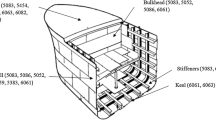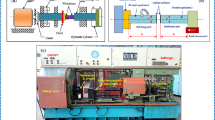Abstract
In this work, four types of self-shielded flux-cored wires which include two ferritic wires and two nickel-based wires were specifically designed to improve the quality of underwater wet welded E40 steel joints. The effect of different wires on arc stability and the metal transfer process was examined. The slag obtained in the wet welding process with flux-cored wires was collected, milled, and subsequently analyzed. The microstructural features, mechanical performance and susceptibility to cold cracking of underwater wet welded joints were comparatively evaluated. The results showed that all the welds presented acceptable bead appearance. The arc stability of the ferritic wires with TiO2-based slag system was found to be superior to that of the Ni-based wires with CaF2-based slag system. Further, different flux-cored wires did not alter the typical metal transfer modes, however, they changed the relative proportion of the metal transfer modes. The underwater wet welded joints were free from cold cracks, which were indicated by the Y-groove restraint test. The developed self-shielded flux-cored wires possessed superior performance in terms of strength and toughness in shallow water.


















Similar content being viewed by others
Data Availability
The raw data generated during the present study are available from the corresponding author on reasonable request.
References
J. Klett and T. Hassel, Influence of Stick Electrode Coating’s Moisture Content on the Diffusible Hydrogen in Underwater Wet Shielded Metal Arc Welding, Adv. Mater. Sci., 2020, 20(4), p 27–37.
S.G. Parshin, A.M. Levchenko, and A.S. Maystro, Metallurgical Model of Diffusible Hydrogen and Non-Metallic Slag Inclusions in Underwater Wet Welding of High-Strength Steel, Metals, 2020, 10(11), p 1498.
J. Tomków, D. Fydrych, and K. Wilk, Effect of Electrode Waterproof Coating on Quality of Underwater Wet Welded Joints, Materials, 2020, 13(13), p 2947.
J. Tomków, D. Fydrych, and G. Rogalski, Effect of the Welding Environment and Storage Time of Electrodes on the Diffusible Hydrogen Content in Deposited Metal, Rev. Metal., 2019, 55(1), p e140.
H.L. Li, D. Liu, N. Guo, and J.C. Feng, The Effect of Alumino-Thermic Addition on Underwater Wet Welding Process Stability, J Mater. Process Tech., 2017, 245, p 149–156.
E.C.P. Pessoa and S. Liu, The State of the Art of Underwater Wet Welding Practice: Part 1, Weld. J, 2021, 100, p 132–141.
M.D. Rowe, S. Liu, and T.J. Reynolds, The Effect of Ferro-Alloy Additions and Depth on the Quality of Underwater Wet Welds, Weld. J., 2002, 81(8), p 156–166.
S.Y. Maksimov, Development of MMA Electrodes for Manual Underwater Welding in all Spatial Positions of Steels. International Seminar and Workshop on Underwater Wet Welding and Cutting. Middlesbrough, UK, 1997, pp 32–44.
K.A. Yushchenko, Y.Y. Gretskii, and S.Y. Maksimov, Study of Physico-Metallurgical Peculiarities of Wet Arc Welding of Structural Steels. International Seminar and Workshop on Underwater Wet Welding and Cutting. Middlesbrough, UK, 1997, pp 6–29.
V.R. Santos, M.J. Monteiro, F.C. Rizzo, A.Q. Bracarense, E.C.P. Pessoa, R.R. Marinho, and L.A. Vieira, Development of an Oxyrutile Electrode for Wet Welding, Weld. J., 2012, 91(12), p 319–328.
F. Pérez-Guerrero and S. Liu, Explaining Porosity Formation in Underwater Wet Welds. International Conference on Offshore Mechanics and Arctic Engineering. San Diego, USA, 2007, pp 249–257.
M. Rowe and S. Liu, Recent Developments in Underwater Wet Welding, Sci. Technol. Weld. Join., 2001, 6(6), p 387–396.
L.O. Vilarinho, B. Lucas, and S. Raghunathan, Initial Trials of Underwater Wet Welding Using Mechanised FCAW Process. 20th International Congress of Mechanical Engineering (COBEM). Gramado, RS, Brazil, 2009, pp 15–20.
C.B. Jia, T. Zhang, S.Y. Maksimov, and X. Yuan, Spectroscopic Analysis of the Arc Plasma of Underwater Wet Flux-Cored Arc Welding, J Mater. Process. Technol., 2013, 213(8), p 1370–1377.
N. Guo, Y.L. Fu, J.C. Feng, Y.P. Du, Z.Q. Deng, M.R. Wang, and D.Y. Tang, Classification of Metal Transfer Mode in Underwater Wet Welding, Weld. J., 2016, 95(4), p 133–140.
J.F. Wang, Q.J. Sun, S. Zhang, C.J. Wang, L.J. Wu, and J.C. Feng, Characterization of the Underwater Welding Arc Bubble Through a Visual Sensing Method, J Mater. Process. Technol., 2018, 251, p 95–108.
H.T. Zhang, X.Y. Dai, J.C. Feng, and L.L. Hu, Preliminary Investigation on Real-Time Induction Heating-Assisted Underwater Wet Welding, Weld. J., 2015, 1, p 8–15.
Q.J. Sun, W.Q. Cheng, Y.B. Liu, J.F. Wang, C.W. Cai, and J.C. Feng, Microstructure and Mechanical Properties of Ultrasonic Assisted Underwater Wet Welding Joints, Mater. Des., 2016, 103, p 63–70.
J.F. Wang, Q.J. Sun, Z.C. Pan, J. Yang, and J.C. Feng, Effects of Welding Speed on Bubble Dynamics and Process Stability in Mechanical Constraint-Assisted Underwater Wet Welding of Steel Sheets, J Mater. Process. Technol., 2019, 264, p 389–401.
N. Guo, Y.P. Du, S. Maksimov, J.C. Feng, Z.Q. Yin, D. Krazhanovskyi, and J.C. Feng, Study of Metal Transfer Control in Underwater Wet FCAW Using Pulsed Wire Feed Method, Weld. World, 2018, 62(1), p 87–94.
H. Chen, N. Guo, X.H. Shi, Y.P. Du, J.C. Feng, and G.D. Wang, Effect of Hydrostatic Pressure on Protective Bubble Characteristic and Weld Quality in Underwater Flux-Cored Wire Wet Welding, J Mater. Process. Technol., 2018, 259, p 159–168.
N. Guo, C.S. Xu, Y.P. Du, and J.C. Feng, Effect of Boric Acid Concentration on the Arc Stability in Underwater Wet Welding, J Mater. Process. Technol., 2016, 229, p 244–252.
A.M. Brydon and J.H. Nixon, An Investigation into Underwater Wet Welding Using the Flux Cored Arc Welding Process, American Society of Mechanical Engineers, New York, 1995.
S.H. Van den Brink and M.P. Sipkes, Underwater Welding with Flux-Cored Wire. Soudage Sous lEau, 1983, pp 163–170.
V.Y. Kononenko, Mechanised Welding with Self-Shielding, Flux-Cored Wires for Repairing Hydraulic Installations and Vessels in Water, Weld. Int., 1996, 10(12), p 994–997.
H.L. Li, D. Liu, Y.T. Yan, N. Guo, and J.C. Feng, Microstructural Characteristics and Mechanical Properties of Underwater Wet Flux-Cored Wire Welded 316L Stainless Steel Joints, J Mater. Process. Technol., 2016, 238, p 423–430.
H.L. Li, D. Liu, Y.Y. Song, Y.Y. Yan, N. Guo, and J.C. Feng, Microstructure and Mechanical Properties of Underwater Wet Welded High-Carbon-Equivalent Steel Q460 Using Austenitic Consumables, J Mater. Process. Technol., 2017, 249, p 149–157.
E.C.P. Pessoa, A.Q. Bracarense, and S. Liu, Exothermic Additions in a Tubular Covered Electrode and Oxidizing Reactions Influence on Underwater Wet Welding. ASME 26th International Conference on Offshore Mechanics and Arctic Engineering. USA, 2007, pp 259–268.
Y. Lizunkova, T. Hassel, and J. Klotz, A. Wolyniec and F.W. Bach, Development of Filler Wire for Underwater Welding as a Repair Tool for Adaptation on AUV. In: Oceans 2009-Europe, 2009, pp 1–6.
N. Guo, C.S. Xu, Y.P. Du, H. Chen, Y.L. Fu, and J.C. Feng, Influence of Calcium Fluoride on Underwater Wet Welding Process Stability, Weld. World, 2019, 63(1), p 107–116.
J. Labanowski, K. Prokop-Strzelczynska, and G. Rogalski, The Effect of Wet Underwater Welding on Cold Cracking Susceptibility of Duplex Stainless Steel, Adv. Mater. Sci., 2016, 16(2), p 68–77.
D. Fydrych, J. Łabanowski, and G. Rogalski, Weldability of High Strength Steels in Wet Welding Conditions, Pol. Marit. Res., 2013, 2(78), p 67–73.
J. Tomków, G. Rogalski, and D. Fydrych, Improvement of S355G10+N Steel Weldability in Water Environment by Temper Bead Welding, J Mater. Process Tech., 2018, 262, p 372–381.
R.C. Devries, R. Roy, and E.F. Osborn, Phase Equilibria in the System CaO-TiO2-SiO2, J Am. Ceram. Soc., 1955, 38(5), p 158–171.
L. Sharma and R. Chhibber, Design and Development of Submerged Arc Welding Fluxes Using TiO2-SiO2-CaO and SiO2-CaO-Al2O3 Flux System, Proc. Inst. Mech. Eng. Part E J. Process Mech. Eng., 2019, 233(4), p 739–762.
D. Bhandari, R. Chhibber, N. Arora, and R. Mehta, Investigation of TiO2–SiO2–CaO–CaF2 Based Electrode Coatings on Weld Metal Chemistry and Mechanical Behaviour of Bimetallic Welds, J Manuf. Process., 2016, 23, p 61–74.
V.N. Petetskii, Effect of the Physical Properties of Slag on its Formation When Welding with a Seamless Flux-Cored Wire, Weld. Inter., 1995, 9(7), p 573–575.
R.C. De Medeiros and S. Liu, A Predictive Electrochemical Model for Weld Metal Hydrogen Pickupin Underwater Wet Welds, J. Offshore Mech. Arct. Eng., 1998, 120(4), p 243–248.
Acknowledgments
This research is supported by State Key Lab of Advanced Welding and Joining, Harbin Institute of Technology. We are also grateful for the financial support to this research from the National Natural Science Foundation of China (Grant No. 51905225) and the Postgraduate Research & Practice Innovation Program of Jiangsu Province (Grant No. SJCX20_1400).
Author information
Authors and Affiliations
Corresponding author
Ethics declarations
Conflict of interest
The authors declare that they have no financial interests or personal relationships that could have appeared to influence the work reported in this paper.
Additional information
Publisher's Note
Springer Nature remains neutral with regard to jurisdictional claims in published maps and institutional affiliations.
Supplementary Information
Below is the link to the electronic supplementary material.





Rights and permissions
About this article
Cite this article
Ma, Q., Li, H., Liu, S. et al. Comparative Evaluation of Self-Shielded Flux-Cored Wires Designed for High Strength Low Alloy Steel in Underwater Wet Welding: Arc Stability, Slag Characteristics, and Joints’ Quality. J. of Materi Eng and Perform 31, 5231–5244 (2022). https://doi.org/10.1007/s11665-022-06683-x
Received:
Revised:
Accepted:
Published:
Issue Date:
DOI: https://doi.org/10.1007/s11665-022-06683-x




